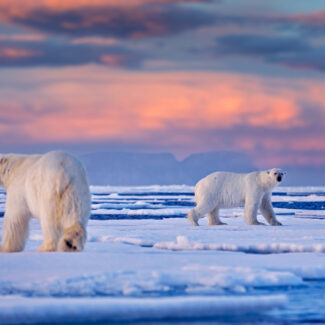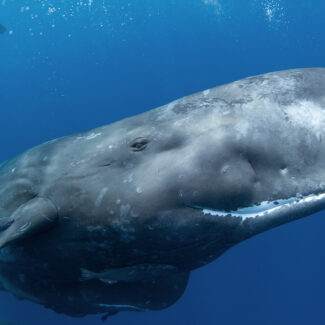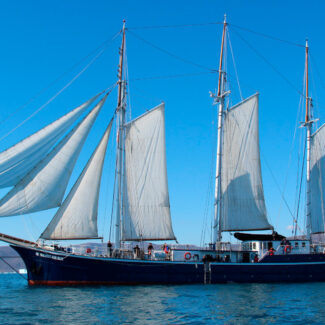Children In Antarctica: Should I Go To Antarctica With Kids?
Is the White Continent suitable for kids? Absolutely! Family getaways to Antarctica can be among the most magical and defining of all your shared travel experiences, without question. But this most remote of destinations definitely warrants some careful thinking about whether it’s ideal for your children.
In this travel guide, we’ll dig more deeply into what makes taking children to Antarctica so appealing, why the White Continent might not be suitable for everyone’s kids, and sketch out some of the best ways to approach a family getaway to this superlative, one-of-a-kind realm at the bottom of the world.
Is Antarctica a Good Travel Destination for Families?
Antarctica is a land of extremes, being the highest, whitest, driest, coldest and windiest continent on Earth. With so many awesome accolades it’s unsurprising that youngsters find themselves intrigued by Antarctica. As adults however, such superlatives may make the prospect of visiting Antarctica seemingly incongruent with kids and the idea of a family vacation.
Perhaps the most common concern is how it might be too cold a destination for little ones. Let’s quickly dispel the common myth about children feeling the cold more than adults. Surprisingly, the opposite is in fact true, as babies and children’s bodies have a higher proportion of “brown fat”—a specialized fat, whose primary role is to generate heat—which decreases as you get older. (Also, you will be visiting the Antarctic Peninsula in the Austral Summer which is where and when conditions are at their mildest.)
Now your fears of its infamous frigidity have been allayed, let’s now take a look at some of the many reasons to go to Antarctica with kids.
Top 5 Reasons To Go To Antarctica With Kids
Antarctica offers so many rewards as a destination for a family vacation there are almost too many to list. So here are just 5 of the top reasons to experience an Antarctic expedition with your children:
- Family Bonding: Such an adventurous place to travel together—as ends-of-the-Earth as they come—provides a singular bonding experience to better all others.
- Lifelong Memories: A trip with your kids to the White Continent is one that’ll stay vividly rooted in all of your memories for the long haul.
- Education: Geography, science, astronomy, history … whatever your children are into, Antarctica is a hotspot (albeit a very cold one) of learning, sure to fascinate and foster bright young minds with its brilliant geological features and exploration heritage.
- Ecotourism: Nowhere on Earth are ecosystems as fragile and climate change more apparent than in Antarctica. Through ecotourism activities and the education of visiting children in Antarctica kids will become advocates for the planet and its future.
- Penguins: From Pingu to Happy Feet, the appeal of penguins on our little people is apparent, and so what better place to visit than Antarctica (and the sub-Antarctic islands) where 12 million penguins and 8 species can be found.
Top Family Antarctic Activities
Kids old enough to appreciate the exotic adventure of Antarctica can have an utterly incredible time on a voyage to the bottom of the world. Among the top family activities to enjoy on an expedition cruise are:
- Wildlife-watching: From penguin colonies and pupping seals to orcas, humpbacks, and minke whales, polar wildlife is astonishing—and, in typical cruise destinations and seasons, typically abundant and easy to see. Antarctica’s critters have all-ages appeal.
- Kayaking: Among the most memorable things to do in Antarctica is guided kayaking, offered as an activity on many cruises. Paddling among ice floes delivers an incredibly intimate look at the marine and coastal environment, and definitely injects some adventure into the day’s sightseeing.
- Trekking Onshore: Depending on the season, the location, and the tour operator, guided onshore outings are available which allow families to make landfall on Antarctica together. These might take the form of hiking, cross-country skiing, or even snowshoeing. Kids (and—let’s face it—grownups, too) will thrill to step where few people ever have.
- Campouts: Many tours to the Antarctic Peninsula, the busiest sightseeing area on the White Continent, offer overnight camping experiences on nearshore islands or the mainland. Cozied up in a bivy sack or tent, spending the night under the polar sky is as once-in-a-lifetime as they come, and a great choice for many families.
- Visit the Historic Scott and Shackleton Huts of McMurdo Sound: Older kids with an interest in adventure or history will likely be wowed by a visit to one or both of the famous historic huts on Ross Island in McMurdo Sound, reached by certain cruises. Scott’s Hut—the headquarters of Robert Falcon Scott’s doomed Terra Nova expedition of 1910-1913—still stands on Cape Evans, seemingly untouched. Similarly, the clothes, foodstuffs, and other materials of Ernest Shackleton’s crew can still be seen within that 1907-1909 expedition’s hut on Cape Royd.
- Experience the Polar Plateau: Certain tour packages offer flights into the high-elevation, iced-over wilderness of East Antarctica, which is just about as far away from anything as you can get. Give your kids the experience of a lifetime with a visit to the South Pole—the Ceremonial South Pole with its array of international flags promises one of the world’s greatest photo ops, needless to say—or arrange a family stay at the staggeringly remote, but surprisingly decked-out, luxury camps run by White Desert.
Considerations For Taking Children To Antarctica
However alluring any destination, there are usually some crucial considerations to be cognizant of before booking your trip, and Antarctica is no different, perhaps even more so than anywhere else given the extreme conditions, logistics, and costs involved in such a once-in-a-lifetime journey.
When it comes to choosing the White Continent as a family getaway, here are the most important factors to consider:
Age Restrictions
Despite Antarctica’s appeal to young and old, it’s important to note that many Antarctica tours aren’t suitable for all ages, indeed many set a minimum age limit: often 12 years old, though some ease that down to eight years old or so.
Why this lower-age cutoff? Many vessels, especially the smaller expedition-style ships popular for exploring Antarctica, aren’t all that well set up for young children. They may feature handrails out of reach of pintsized passengers, for example. And from the infamously tumultuous seas of the Drake Passage (more on that here) to rough Zodiac landings, conditions may be a bit too rigorous for tykes. (You can, of course, skip the Drake Passage via a fly-and-cruise getaway.)
Appropriateness
Another reason why Antarctica generally is better-suited to families with teenagers, young adults, and certain tweens is the particular array of onboard amenities and things to do offered on typical cruises.
Lengthy sea crossings can be tedious for those with short attention spans, and most cruise ships to the White Continent are unlikely to provide much in the way of kid-specific attractions. Smaller research or expedition vessels may offer a restaurant, bar, library, and perhaps a gym, while larger, more luxurious cruise ships often boast multiple eateries, saunas, hot tubs, and the like. Welcome as they are for adults, such features aren’t exactly the most interesting to little kids.
And one of the fundamental activities aboard many Antarctic cruises is ship-based educational lectures on the natural and human history of the White Continent: a fantastic component of these trips that deepens your appreciation and expands your understanding of the amazing sights you’re seeing. Such talks, however, will likely be somewhat over the heads of many younger kids.
That said, if you’ve got a young child who’s particularly fascinated by the natural world, an Antarctic expedition may be wonderfully appropriate: from the onboard lectures to the world-class wildlife-watching both offshore and on.
Caveat
Bear in mind that not all Antarctica tour operators enforce an age minimum, and that the lower-age cutoff advertised by others is sometimes just a recommendation, not a mandate.
All of the above notes of caution may not apply to your situation: You, of course, know the abilities and interests of your child best of all. Families with eight- and nine-year-olds have enjoyed all-around incredible journeys to the White Continent together.
Cost
Even if your children are of a suitable age and disposition to join you on your journey to the South Pole, deciding whether or not to take your children to Antarctica with you may ultimately become a question of affordability. Given the inherent costs involved in expeditions to this remote realm, the financial implications of taking the entire family can be considerable, even with the child discounts available (which max out at around 25% of the adult cost). Then again, how can you put a price on such an opportunity for them?
A Word Of Caution
As with any vacation, especially in the extreme polar environment of Antarctica, it goes without saying that caution should be taken when it comes to children’s sensitive skin and eyesight. To avoid sunburn, eye damage, and dehydration, parents should ensure their children have ample sunblock, chapstick, sunglasses and a reusable water bottle on hand at all times.
That said, parents with such concerns—or indeed, accident prone offspring—can take peace of mind in the fact that all expedition ships sailing to Antarctica have a small medical clinic and a doctor on board to treat minor illnesses or injuries.
Best Antarctic Cruises With Kids
It’s also important to be aware that some vessels voyaging the Southern Ocean are more kid-friendly than others, not just in terms of their on board amenities, but also with regards both the clientele you’ll be sharing your expedition with, and the itineraries they sail, with some being more suitable and active for those with energetic youngsters.
Some ships also offer children’s educational programs on select departures (usually offered on the holiday cruises around Christmas and New Years), which have a children’s activity coordinator on board responsible for developing educational activities specifically designed around the interests of younger travelers.
We’ve got our own dedicated page on the best cruise vessels for family trips to Antarctica right here. As far as family-friendly accommodations go on such ships, they’re usually easy to arrange via larger suites—some larger vessels have limited quadruple or triple cabins available—and/or reserving adjoining double cabins.
Travelers are often pleasantly surprised by the caliber and variety of dining aboard Antarctic cruises. Some tours offer established kid menus, and/or kitchens willing to whip up something special for a particularly picky eater, but it’s a good idea to check in advance on this sort of thing if you do have a child who’s a bit difficult at the dinner table.
Minting Family Memories on the White Continent
Ready to partake in the polar plunge and take a family foray to the Far South? To further whet your appetite for such a bucket-list voyage, be sure to check out some of our other resources focused on family adventures in this special place. Alternatively, should you have any concerns or queries at all about whether Antarctica is right for your children, or what vessels and itineraries are best for your family, don’t hesitate to get in touch with us.
Disclaimer
Our travel guides are for informational purposes only. While we aim to provide accurate and up-to-date information, Antarctica Cruises makes no representations as to the accuracy or completeness of any information in our guides or found by following any link on this site.
Antarctica Cruises cannot and will not accept responsibility for any omissions or inaccuracies, or for any consequences arising therefrom, including any losses, injuries, or damages resulting from the display or use of this information.










